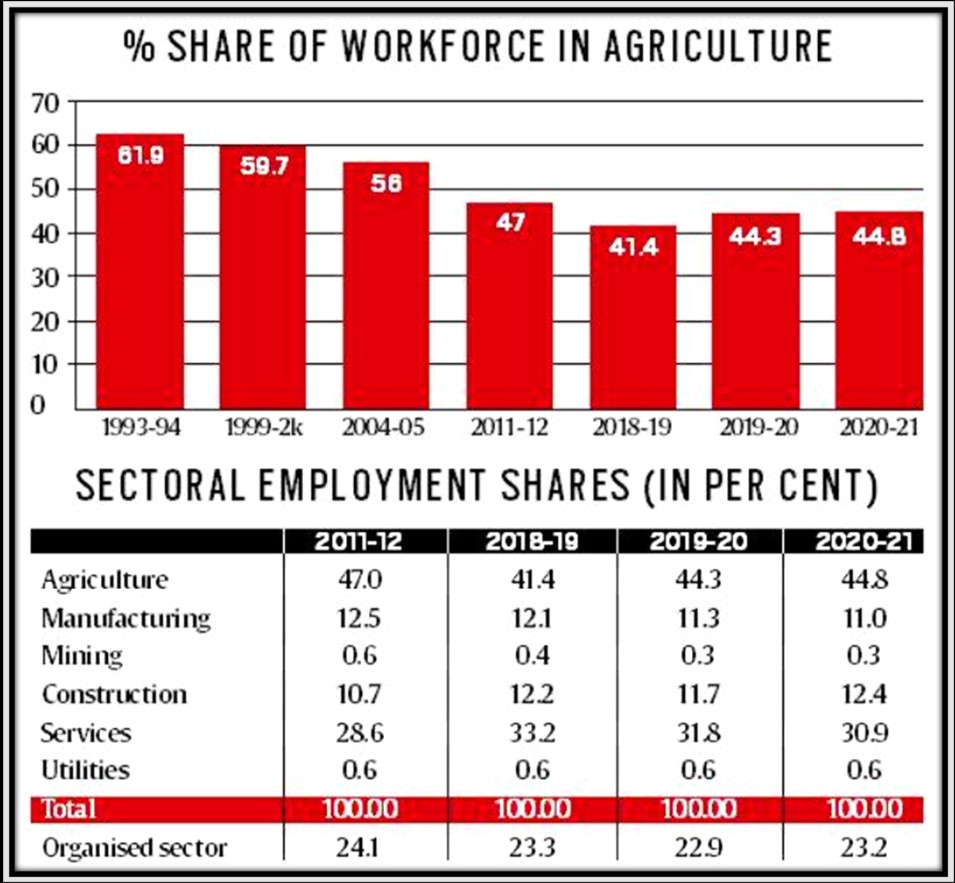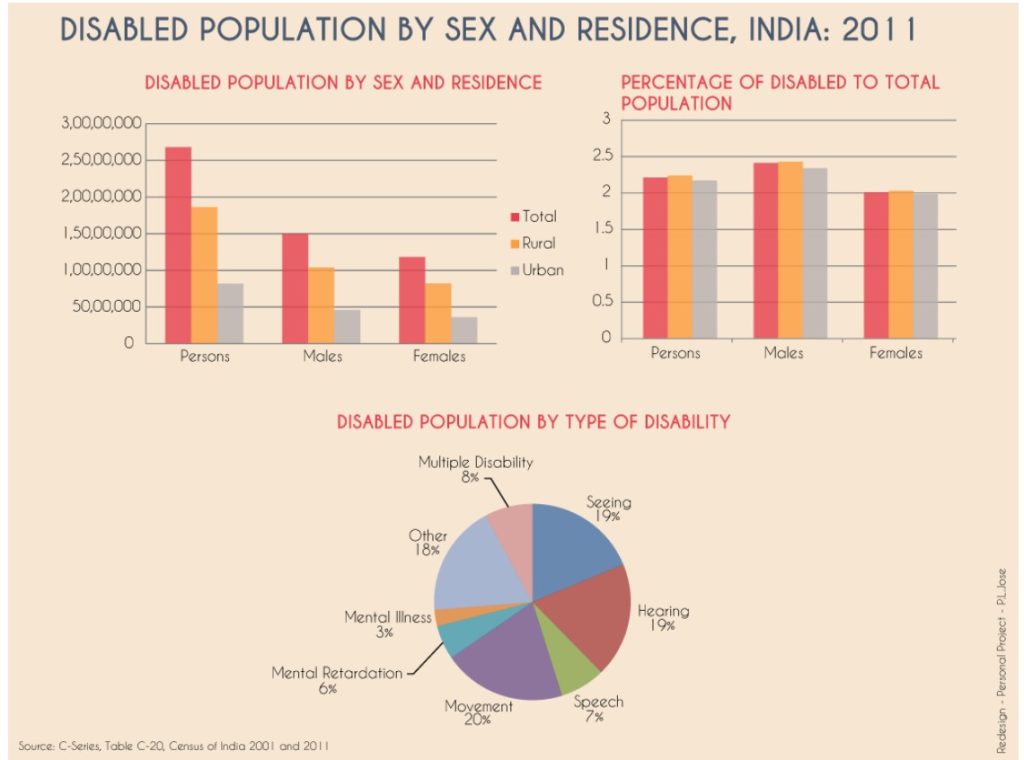CONTENTS
- Navigating Farmer Discontent Amid Unfulfilled Promises
- India will be a True Welfare State when Discrimination is Eliminated
Navigating Farmer Discontent Amid Unfulfilled Promises
Context:
Agriculture has long been a fundamental part of India’s economy and societal framework. Despite its importance, the sector has experienced a strained relationship with the central Government in recent years. Approximately 65 percent of India’s population resides in rural areas, with 47 percent dependent on agriculture.
Relevance:
GS3-
- Different Sectors of the Economy
- Cropping Patterns
- Food Security
Mains Question:
As the government embarks on its third tenure, winning back the trust of the farming community will require genuine and substantial reforms that prioritise farmers’ welfare. Analyse. (15 Marks, 250 Words).
Growth of the Agriculture Sector in India:

- Despite India’s rapid economic expansion, agricultural income has remained stagnant, averaging around Rs 10,000 per month in 2019, with half of the families in debt and lacking access to traditional financing.
- Public investment in agriculture has decreased over the past decade, and necessary reforms have not been implemented.
- As a result, the agriculture sector, which employs nearly half of India’s workforce, contributes less than one-fifth to the GDP. The Government’s pledge to double farmers’ income by 2022 has not been fulfilled.
Farmer’s Reaction to Policies Aiming to Transform Agriculture:
- The ambitious promises and policies from the Union Government intended to transform agriculture have often been met with skepticism and frustration from the farming community.
- This dissatisfaction was clearly evident in the recent general election results in States like Rajasthan, Haryana, Punjab, and Uttar Pradesh.
- Persistent issues in the sector, such as the controversial farming laws and the unfulfilled demand for a legal guarantee of the Minimum Support Price (MSP), continue to provoke farmers’ distress and anger.
- During the government’s first term beginning in 2014, there was a significant emphasis on agriculture with a pledge to double farmers’ income. However, these promises were marred by controversies and policies seen as anti-farmer.
- The discontent among farmers peaked in 2020-21, leading to nationwide protests against farm laws intended to liberalize crop sales, pricing, and storage regulations.
- The protests concluded after the government agreed to repeal these laws. Farmers demanded a legally guaranteed Minimum Support Price (MSP) for 23 crops, set at 50 percent above production costs as recommended by scientist MS Swaminathan.
- Although the Government sets MSPs for 22 crops, it mainly purchases wheat and rice for welfare programs, and private buyers are not legally required to pay MSP. The farm laws, intended to liberalize agriculture, were perceived by many farmers as a threat to their livelihoods.
- The ensuing prolonged protests resulted in the withdrawal of these laws, but the underlying dissatisfaction remained.
- This ongoing frustration was reflected in the recent Lok Sabha elections, where the ruling party suffered notable losses in key agricultural regions.
Way Forward:
- Looking ahead, newly appointed Agriculture Minister will need to leverage his expertise in transforming Madhya Pradesh’s agricultural landscape on a national scale to tackle these challenges.
- One of the critical demands from the farming community is the legal guarantee of the Minimum Support Price (MSP).
- The Government’s failure to meet this demand has been a major source of frustration. Farmers argue that a legally guaranteed MSP would protect them against market fluctuations and exploitation by middlemen.
- Despite multiple assurances, the administration has not enacted legislation to this effect, leading to a perception that farmers’ interests are being overlooked.
- Experts suggest that legally guaranteeing MSP could result in fiscal burdens and potential inflationary effects, though opinions differ on the extent of this impact. Some argue that controlling cultivation costs could mitigate inflation concerns.
- The cost of implementing MSP for all crops is uncertain, varying with market prices, Government procurement quantities, and duration.
- Estimates range from CRISIL Market Intelligence & Analytics’ 210 billion rupees to other analysts’ 10 trillion rupees annually.
- A more effective approach might involve direct income support linked to farmland investment, alongside revamping the current procurement process. Farmers could also benefit from a price stabilization fund to cover the difference when market prices fall below MSP levels.
- This combination of strategies could better support farmers without causing significant fiscal or inflationary issues.
Conclusion:
In response to the ongoing challenges in the agricultural sector, the Government plans to introduce several initiatives to appease the agrarian community. Among these, the Krishi Sakhi Convergence Program (KSCP) stands out as a significant and ambitious effort. The Government’s focus on agriculture, highlighted by programs like the KSCP, reflects a recognition of the critical role farming plays in India.
India will be a True Welfare State when Discrimination is Eliminated
Context:
In India’s vibrant democratic fabric, the concept of a welfare state has been fundamental since its inception. Rooted in the Constitution, the commitment to justice, equality, and the advancement of general welfare defines India’s core values. Yet, within this noble vision lies a stark reality often overlooked—the profound challenges confronting individuals with disabilities.
Relevance:
GS2- Welfare Schemes for Vulnerable Sections of the population by the Centre and States and the Performance of these Schemes
Mains Question:
India’s genuine progress will be reflected in its dedication to inclusivity, especially in upholding the dignity of individuals with disabilities. Analyse. (10 Marks, 150 Words).
Disability in India:

- Despite the presence of legal frameworks such as the Rights of Persons with Disabilities Act, 2016, and international commitments like the United Nations Convention on the Rights of Persons with Disabilities (2006) and the Sustainable Development Goals (SDGs), the everyday realities faced by people with disabilities present a contrasting narrative.
- In India, disability represents more than a physical or mental condition; it embodies a multifaceted barrier that obstructs access to fundamental rights and opportunities.
- From systemic discrimination to inadequate infrastructure, individuals with disabilities encounter hurdles in all aspects of life.
- Essential areas like education, employment, and healthcare—foundations of a welfare state—often remain distant aspirations for them.
Education as a Tool of Empowerment:
- Education is frequently touted as crucial for progress and empowerment. However, many disabled students in India face significant barriers to accessing quality education.
- Despite the existence of the National Education Policy and the Right to Education Act, educational institutions often lack the necessary support systems and infrastructure to accommodate diverse needs.
- There is a stark disparity in enrollment rates between disabled and non-disabled students, with the national average for non-disabled students at 28.4% compared to less than 2% for disabled students, according to government data from UDISE+. Moreover, dropout rates exceed 75% among students with disabilities in higher education.
Employment Landscape:
- Likewise, the employment landscape for persons with disabilities remains grim. Despite efforts to promote inclusivity, the private sector often shows reluctance, citing concerns about productivity, costs, and a perceived shortage of skilled resources.
- Consequently, unemployment rates among the disabled population are disproportionately high, exacerbating their economic vulnerability and dependence on social welfare programs.
Access to Healthcare:
- Healthcare, another critical pillar of a welfare state, poses unique challenges for persons with disabilities.
- Limited access to specialized care, the high costs associated with assistive devices, and stigma within healthcare facilities all contribute to their marginalized status.
- Amid these challenges, India’s identity as a welfare state often fails to meet the needs of millions of disabled citizens.
Way Forward:
- Firstly, disability should be seen not as a limitation but as a form of diversity that enriches society. Secondly, substantial investments are required in creating accessible infrastructure and services across all sectors.
- This includes constructing barrier-free buildings and implementing inclusive technology to foster equal participation.
- Proactive measures such as affirmative action policies, vocational training programs, and initiatives to sensitize employers are essential steps forward.
- Achieving a genuinely inclusive society demands coordinated efforts on multiple fronts. India’s path towards fulfilling its role as a welfare state must prioritize the rights and dignity of persons with disabilities.
- Disability inclusion should be integrated into every aspect of policy and decision-making, rather than being an afterthought.
Conclusion:
The true essence of a welfare state isn’t solely about lofty ideals or legislative frameworks, but about real and measurable improvements in the lives of its most vulnerable members. It is crucial for the government, civil society, and the private sector to translate rhetoric into action and ensure the inclusion and empowerment of persons with disabilities.



